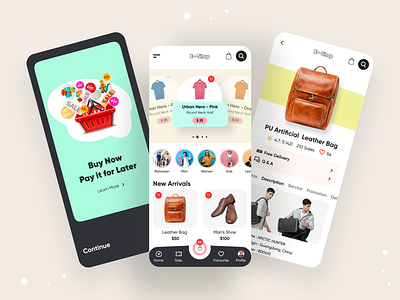From Beta Testing to Launch Day: Preparing Your Ecommerce App for Market Success
In the current digital era, developing an e-commerce application is a crucial tactic for companies trying to increase consumer involvement and broaden their market reach. The path from the initial idea to a successful launch ecommerce app is not without its difficulties and opportunities, though. With an emphasis on the move from beta testing to launch day, we will go over the crucial phases of getting your e-commerce app ready for the market in this extensive tutorial.
Understanding the Importance of a Well-Prepared Launch
The goal of launching an e-commerce app is to provide a smooth user experience that delights consumers from the time they interact with it. This goes beyond simply making the app available for download. An effective launch can have a big impact on sales performance overall, brand reputation, and user retention. Preparation is essential for the following main reasons:
- User Expectations: Modern users need intuitive, high-caliber applications. Low download rates and negative reviews can arise from not living up to these expectations.
- Competitive Advantage: A well-executed launch can set your software apart from rivals in a congested industry. Customers are more inclined to select an app that looks well-designed and useful.
- Initial User Base: A strong launch strategy can help generate buzz, leading to a larger initial user base. Early adopters can provide valuable feedback and become advocates for your brand.
The Role of Beta Testing in App Development
A critical stage in the creation of apps is beta testing. It enables you to obtain practical insights and spot any problems that can impede the performance of your app. This is why beta testing is so important:
- Real User Feedback: By providing input based on their real-world experiences, beta testers can help you find bugs, usability problems, and features that might use some refinement.
- Performance Assessment: Putting the app through its paces in a real-world setting might help identify performance problems that may not have come up in internal testing.
- Market Readiness: Prior to the official launch, beta testing enables you to determine whether your software satisfies user expectations and market demands.
Setting Up Your Beta Testing Program
In order to optimize the advantages of beta testing, an organized strategy is required. The following are essential actions to set up a successful beta testing program:
Define Your Objectives
Clearly outline what you want to achieve with your beta testing. This could include identifying bugs, assessing usability, or testing specific features.
Select Your Beta Testers
Choose a diverse group of testers that represent your target audience. You can recruit beta testers through:
- Social Media: Use platforms like Facebook, Twitter, and Instagram to invite followers to participate.
- Email Lists: Reach out to existing customers who may be interested in helping you improve your app.
- Online Forums and Communities: Engage with relevant online communities to find potential testers.
Create a Testing Schedule
Develop a timeline that outlines the duration of the beta testing phase, including specific milestones such as feedback collection and analysis periods.
Provide Clear Instructions
Ensure that your testers know what to expect and how to provide feedback. This includes offering guidance on how to use the app, report issues, and suggest improvements.
Collecting and Analyzing Feedback
After your beta testing program starts, gathering feedback efficiently is essential. The following techniques can be used to collect and evaluate tester feedback:
Utilize Surveys and Questionnaires
Create surveys that cover various aspects of the app, including usability, performance, and features. Tools like Google Forms or Typeform can facilitate this process.
Encourage Open Communication
Set up channels (like Slack or Discord) for testers to discuss their experiences and share feedback in real time. This can help foster community and encourage more detailed input.
Monitor User Behavior
Incorporate analytics tools (like Google Analytics or Firebase) to track how users interact with your app. This data can highlight patterns that may not be captured through surveys.
Categorize Feedback
Organize feedback into categories (e.g., usability issues, feature requests, bugs) to streamline the analysis process. Prioritize issues based on their impact on user experience and app performance.
Implementing Changes Post-Beta Testing
Now that you’ve gathered and examined user input, it’s time to enhance your program. There are multiple crucial steps in this process:
Prioritize Changes
Not all feedback will be equally important. Identify which issues need immediate attention and which can be addressed later. Focus on high-impact changes that enhance user experience.
Develop an Update Plan
Create a roadmap for implementing changes based on prioritized feedback. Set realistic deadlines for each update and ensure your development team is aligned.
Test the Changes
Once updates are made, conduct thorough testing to ensure that the fixes work as intended and do not introduce new issues. You may want to run a second round of beta testing to validate these changes.
Document the Process
Keep detailed records of the feedback received, changes made, and any additional testing conducted. This documentation will be valuable for future updates and can serve as a learning resource for your team.
Preparing for Launch Day
As you approach launch day, there are several key tasks to complete to ensure a smooth rollout:
Finalize App Store Listings
Prepare your app store listings, including compelling descriptions, keywords for search optimization, and high-quality screenshots or videos showcasing your app’s features.
Conduct a Pre-Launch Marketing Campaign
Create a buzz around the launch of your app with a marketing campaign. This may consist of:
- Email Newsletters: Let your readers know about the features and impending launch.
- Social Media Teasers: Post countdowns and sneak peeks on your social media accounts.
- Influencer Collaborations: Work together with influencers to market your app and expand your user base.
Prepare Customer Support
Establish a customer assistance infrastructure in advance of anticipated consumer questions and issues. Make sure the people on your team are qualified to respond to typical inquiries about the features and functionality of the app.
Perform Final Testing
Perform a comprehensive last round of testing to make sure everything is working as it should. This includes ensuring that the app complies with app store requirements, testing all of the features, and ensuring that it works on various devices.
Marketing Strategies for Your Launch
Efficient marketing tactics are necessary for a launch to be successful in order to increase user engagement and downloads. Think about the following strategies:
Leverage App Store Optimization (ASO)
Optimize your app store listing to increase visibility. This involves using relevant keywords, compelling descriptions, and eye-catching graphics.
Launch-Day Promotions
Consider offering promotions on launch day, such as discounts for early adopters or exclusive features for the first wave of downloads.
Utilize Social Media Marketing
Engage your audience on social media by sharing stories, testimonials, and user-generated content. Create excitement for your launch with countdowns and interactive postings.
Paid Advertising
Invest in targeted ads on networks such as Facebook, Instagram, and Google Ads to reach potential customers looking for ecommerce solutions.
Engage with the Press
Reach out to relevant blogs and media outlets to get press coverage for your app launch. A well-timed news release can spark tremendous attention.
Post-Launch Considerations
After your app is live, the work doesn’t stop. Focus on the following areas to ensure ongoing success:
Monitor Performance Metrics
Utilize analytics tools to track user engagement, retention rates, and conversion rates. Understanding how users interact with your app will inform future updates and marketing strategies.
Gather Post-Launch Feedback
Continue to collect user feedback after launch to identify areas for improvement. Encourage reviews and ratings on app stores to gain insights into user satisfaction.
Regular Updates
Plan for regular updates to keep your app fresh and relevant. This includes fixing bugs, adding new features, and enhancing overall performance based on user feedback.
Maintain Customer Engagement
Keep users engaged through push notifications, email newsletters, and loyalty programs. Encourage feedback and foster a community around your app to promote long-term success.
Conclusion
The transition from beta testing to launch day is vital to the success of your ecommerce software. By investing time and resources in comprehensive testing, user feedback collection, and clever marketing, you can ensure a successful launch that resonates with your intended audience. Remember that the launch is only the beginning; ongoing improvement and user engagement are critical for long-term success in the competitive ecommerce landscape. With proper planning and execution, your app may grow and add considerable value to both your users and your organization.
This tutorial gives a detailed road map for navigating the essential stages of developing an ecommerce app for market success. By implementing these best practices, you can create an app that not only meets user expectations but also supports long-term success for your company.






